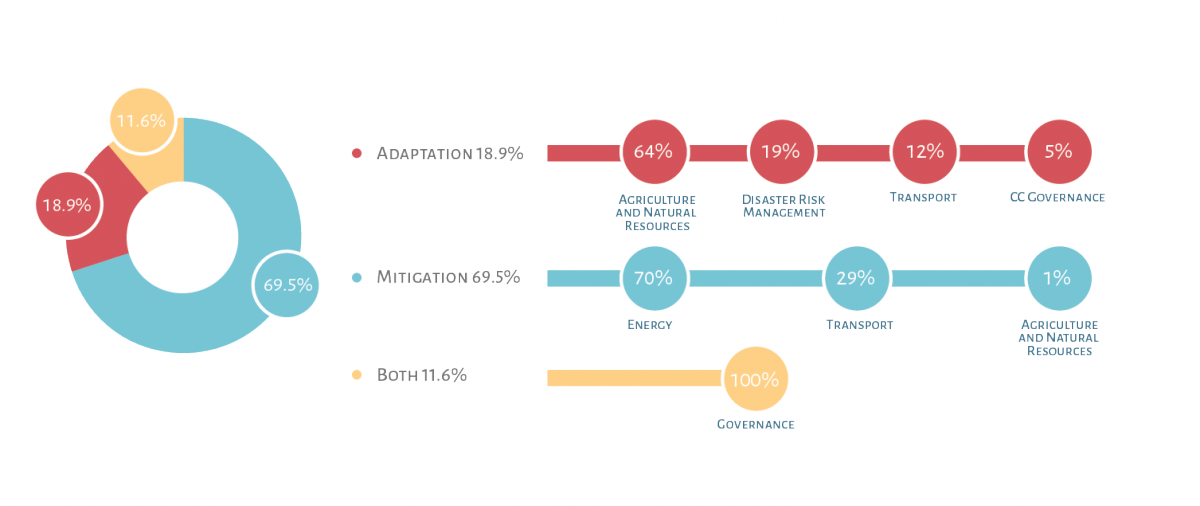Independent evaluation of the Inter-American Development Bank's work on climate change in Latin America and the Caribbean: 3 Main Takeaways
Independent evaluation of the Inter-American Development Bank?s work on climate change in Latin America and the Caribbean: 3 Main Takeaways
The Inter-American Development Bank (IDB) approved more than US$20 billion to finance climate-related projects in Latin America and the Caribbean (LAC) between 2004 and 2013. In its independent evaluation, the IDB?s Office of Evaluation and Oversight (OVE) assessed the extent to which IDB projects contributed to climate change mitigation and adaptation in Latin America and the Caribbean (LAC).
These are 3 takeaways from OVE's evaluation:
- Climate change investments at the IDB have increased significantly since 2004, mostly for mitigation in the energy sector
The IDB?s climate-related lending increased from US$500 million in 2004 to US$2 billion in 2013. Two thirds of the lending financed mitigation activities primarily in the energy sector (excluding energy-related transport activities).

Source: IADB, Mitigation and adaptation loans and grants by sector and areas (original approved amounts)
Why the focus on energy?
LAC?s Greenhouse Gas (GHG) emission?s profile is different from the rest of the world. LAC produces the lowest levels of GHG emissions from the transformation and use of energy. However, OVE found that more than 75% of energy projects financed by the IDB in the evaluation period included climate change mitigation strategies.
Why would the IDB devote the majority of its efforts to financing mitigation activities in the energy sector? Because there are unexploited opportunities to reduce emissions in this sector. For example, OVE estimated that IDB?s direct investments in renewables (mainly hydropower) could mitigate the equivalent of about 2% (10 million tCO2 per year) of the region?s electricity emissions.

Source: IADB, Emissions profile by sector and by region in 2011
Transport and agriculture - missed opportunities
Although transport is the fastest growing source of energy-related GHG emissions in LAC, only a third of IDB operations included mitigation strategies, most of which are related to urban transport solutions. Nonetheless, OVE?s in-depth assessment of two bus rapid transit systems (BRTs) and two metro lines suggests that there are opportunities for significant emission reductions. For instance, the Cali BRT achieved a 40% reduction of GHG emissions and other pollutants thanks to the restructuring of routes which resulted in fewer bus kilometers travelled to serve the same trips. While land use and land use change represents almost 30% of LACs total GHG emissions, the IDB has only devoted 1% of its mitigation portfolio to agriculture and natural resources activities.
- IDB?s work on adaptation lags behind
The frequency of natural disasters such as floods, droughts, hurricanes, and earthquakes is increasing in the region. The economic losses associated with these events are also escalating and represent important development threats. However, the evaluation found that climate adaptation activities accounted for less than 20% of the IDB portfolio and focused mainly on agriculture and disaster risk management. Why?
One of the reasons is that climate change adaptation policies in LAC are still being developed and consequently there are no clear lines of action to address these issues. Additionally, climate adaptation results are particularly difficult to assess and measure.
For example, in agriculture the IDB has focused on improving plant and animal health, increasing agricultural research and innovation, and improving water resource management. However, IDB?s overall effectiveness and value-added are difficult to account for because of inadequate measures of results associated with climate change adaptation.
In the area of disaster risk management, the IDB has a long history of supporting the region, and its portfolio is well aligned with country vulnerability levels. Yet, OVE found that the majority of IDB?s portfolio in this sector focuses on disaster prevention and preparedness, while support for climate risk assessment?key to climate adaptation?has been very limited. OVE recommended IDB to deepen its engagement in policy dialogue and operational support to address climate adaptation challenges in the region.
- IDB?s climate change interventions were more effective when they were aligned with other development goals
This is particularly the case for energy and transport. In fact, in the case of the energy sector, the evaluation found that linking IDB energy projects with broader objectives at the national level was crucial in implementing effective mitigation strategies. In other words, IDB projects were more successful when GHG mitigation was introduced in the context of a broader sector goal, such as reducing dependence on imported fossil fuels, providing electricity to remote populations, or increasing energy security by diversifying the energy matrix of the countries.
The evaluation found similar results in transport. While most investments in transport seek to reduce transportation costs and improve the reliability and efficiency of networks, incorporating climate change considerations not only help to reduce GHG emissions but also to generate important co-benefits such as improvements in air quality, traffic safety, and increased mobility and access to good and services.





